Ebony G. Patterson, a finalist for the 1858 Prize for Contemporary Southern Art, has an Honors Diploma in Painting from Edna Manley College for the Visual and Performing Arts, as well as an MFA in Printmaking and Drawing from Sam Fox College of Art and Design at Washington University in St. Louis. She currently lives and works in Lexington, KY. In her work she “explores the tension between the transformed and that which transforms, interrogating the ever-changing relationship between the ‘video light’ and the performed male within dancehall culture.” The Jamaican cultural influence on Patterson’s work is unique in its artistic expression, allowing for a very singular technique and product.
What is your creative process?
Hmmmm that’s hard to say sometimes. I am a mixed-media artist whose practice is grounded in the language of painting. I use drawing, painting, installation, and the performative. But for me the construction of my work is rooted in the language of painting. “Bella Krew” looks at gangs and other social masculine groups as an alternate family in working class communities.
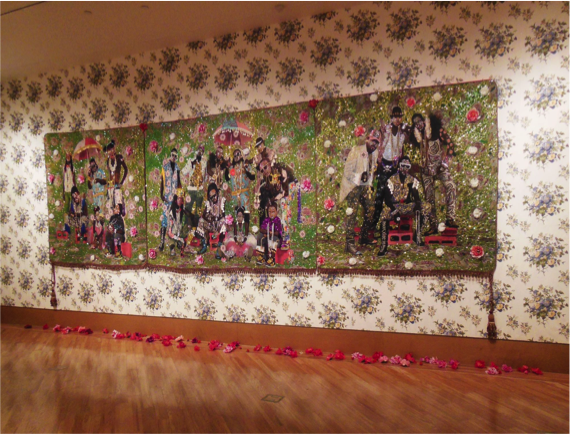
“Bella Krew – From the Fambily Series,” 2012, by Ebony G. Patterson; mixed media jacquard tapestry; variable dimensions.
Where do you draw inspiration for your work?
I draw inspiration from popular culture, current social issues, and of course my homeland Jamaica.
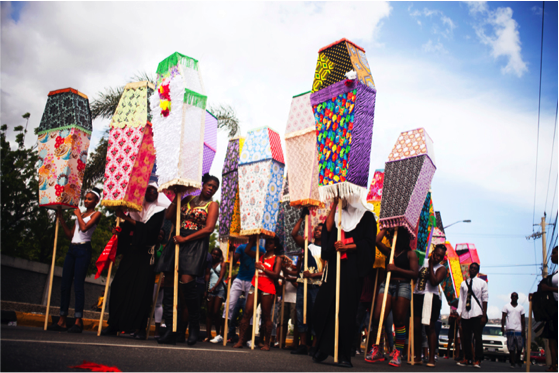
The project is inspired by the pageantry of bling funerals, a growing custom in working class communities in Kingston, Jamaica, that fuses traditional funerary practices and popular cultural aesthetics. This practice is a powerful declaration of presence. ‘You may not have noticed me when I was here, but you will damn well notice me before I leave!’
Who are your artistic influences?
I admire the works of many artists but I can’t say that I am influenced by some more than others. I respect the practices of many, but I am extremely intrigued by dancehall culture and (black) popular culture as a whole. I enthralled by the use of such spaces and its cultural signage that allow for visibility, performativity and pageantry.
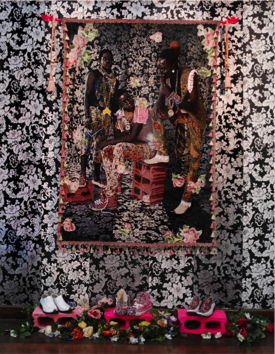
This work looks at the shifts in the Nationalist Period of painting in Jamaica and contemporary representations of domestic spaces. It examines the shifts in domestic space. The women are no longer home they are at work, and the men are on the street corners. The work entails a number of objects that are used often to validate one’s machismo. This work is in direct response to Barrington Watson’s “Conversations.”
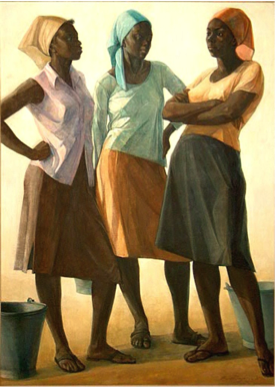
Do you have a favorite of the work that you have produced? If so, please describe it.
Well not really a favorite but there is a work that I see as an important moment that is helping me to enhance new problems. ‘Where we found them,’ is a mixed-media hand embroidered and embellished jacquard tapestry with 100 two toned pink flowers and two pairs of shoes. It’s from the Dead Treez Series.
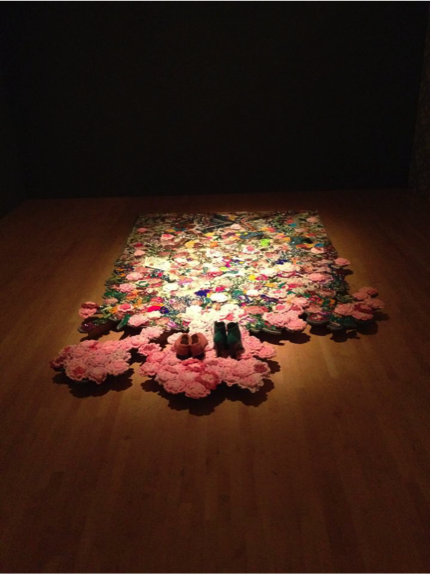
The images are of working class persons who have died under violent circumstances. It is because of the presence of popular cultural archetypes like social media, these horrific images, have made these otherwise invisible persons visible. The recurring question or fact of these persons’ socio-economic realities has remained with me. I question the accessibility and ownership of these images. The fact that social media has illuminated the presence of these otherwise invisible people.
1858 Prize for Contemporary Southern Art Unveiling Party
Thursday, September 17, 6pm
$25 Society 1858 Members, $35 Non-Members
Location: The Drawing Room at The Vendue, 19 Vendue Range
1858 Prize Dinner
Thursday, September 17, 7:30pm
$100 Society 1858 Members, $135 Non-Members
Location: The Gallery at The Vendue, 26 Vendue Range
For more information or to purchase tickets, please visit gibbesmuseum.org/events
—India Dial, Marketing Intern, 2015
For more
Published August 7, 2015

